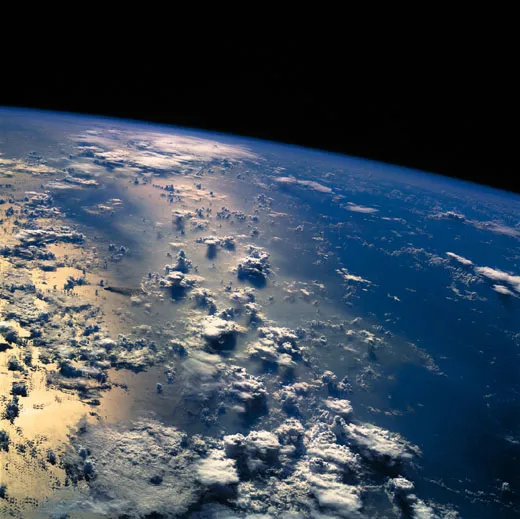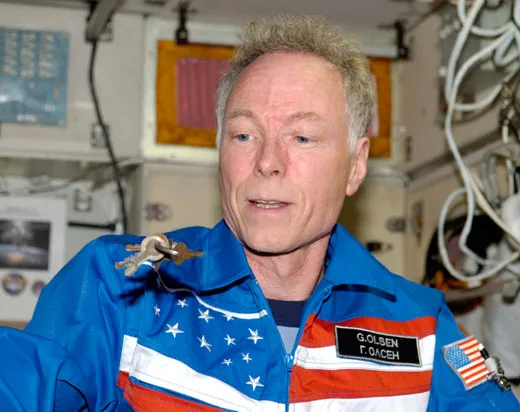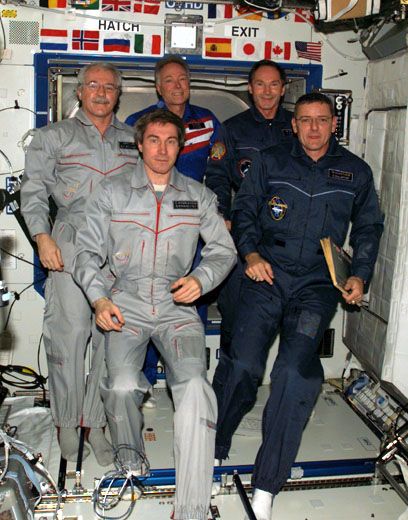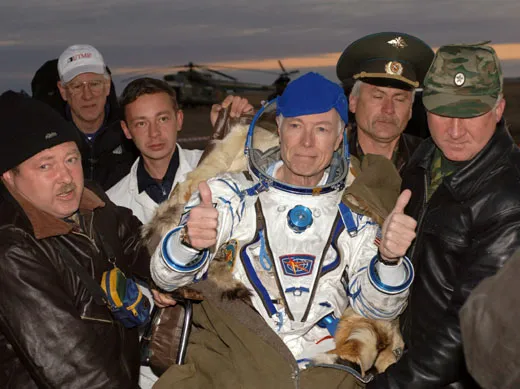Three Million Miles in Ten Days
Floating off to sleep, Earthgazing, making sure the capsule doesn’t depressurize: all standard on a space vacation.
/https://tf-cmsv2-smithsonianmag-media.s3.amazonaws.com/filer/Olsen-flash.jpg)
Astronauts and cosmonauts belong to an exclusive profession, but space tourists who've bankrolled their own trip to orbit? Now that's an elite club. American entrepreneur and scientist Gregory Olsen is one of only seven "spaceflight participants" to have visited the International Space Station, having flown there on the Soyuz TMA-7 spacecraft in 2005. In this condensed excerpt from his 2010 book By Any Means Necessary!: An Entrepreneur's Journey Into Space, Olsen describes his experiences in space.
All told I spent 10 days in low earth orbit—eight of them on the International Space Station. You certainly can’t top the view, from the awe-inspiring globe of the Earth to the stars and planets visible against the black vacuum of space. But my most lasting impressions all revolve around the sensation of weightlessness.
When we first achieved orbit we didn’t have time to consider our new weightless freedom. I was holding various procedure manuals while Valeri [Tokarev] and Bill [McArthur] performed the numerous chores necessary to establish orbital flight, such as a detailed leak-check of the vehicle. Once everything was found to be “nominal” (normal), we could detach our oxygen lines, open our visors and gloves, detach our seatbelts and float! I knew right away I was going to like it. There had been a slight sense of flotation even while we were strapped in. Now we were simply drifting at will. Floating up into the Soyuz spherical habitat module, about seven feet in diameter, I felt free—truly free—WOW!
When we got to the ISS I was in an area about the size of four tractor-trailers, and I could float its entire length just by pushing gently off the back wall. In floating down the station I’d rotate 90°, transforming the ceiling into the right wall, the right wall into the floor, and so forth. Even while I was getting oriented, which took four or five days, the ability to move easily in every direction was truly liberating. I loved zooming up and down the station. A standard cosmonaut trick is to push off from one end of the vehicle and make it all the way to the other end without touching the sides. I never quite made it—it takes a real expert like Sergey Krikalev, our commander on the return flight, to pull that one off!
There are some downsides, of course. Eating or drinking can be a challenge, and personal hygiene (including going to the bathroom) take very different procedures from those you use on earth. Another of the side effects of weightlessness is that blood tends to accumulate in your head. As a result, your body decides there is too much blood in your system and shunts it to the kidneys for filtration and disposal as urine. When that begins to happen, you have to pee more often! At times we were lined up at the urinal hose (really, a vacuum cleaner hose where the suction pulls in the liquid).
Another striking feature of weightlessness is the way physical objects disappear, seemingly of their own accord. I must have taken a hundred or so pictures with my pocket-sized digital camera to capture and preserve my experiences. I kept the camera—where else?—in my shirt pocket. One day it wasn’t there. It had floated out of the pocket and drifted away.
I looked for it before I left the ISS, but with no success. When I got back to earth I sent a message to my crewmate Bill McArthur asking him to keep an eye out for it. Of course it really wasn’t the camera that I wanted, but the memories captured in all those pictures. When he found it, I asked him to download the photos, since he wouldn’t be back for a several months.
Having your pictures sent to you from an orbiting space station was a really cool idea, but while it was easy to do, bureaucracy found a way to complicate the process. Bill was working for NASA and I was a private citizen. The photos were private property, not NASA material. There were issues revolving around them having to bill me for providing the service.
So we compromised. I agreed to give NASA ownership of my photos. Since all NASA photos are in the public domain, freely available to anyone, they could send me the pictures I took without having to bill me for the privilege.
Yeah, that’s right … the only way to get my photos back was to agree they weren’t mine. Bureaucracy is wonderful that way. It’s nice, though, that those pictures are now available for everyone to see.
Crew members are tightly scheduled during their stay on the ISS. Mission control in Houston or Moscow sends up a radiogram each morning that details every hour for every person, including their assigned free time.
The day begins with breakfast around 8, usually combined with a status chat with the ground. Then crew members perform their scheduled duties, be it changing a filter, performing a science experiment, taking photographs, or the daily medical conference.
We all got together at mealtimes. While breakfast was a time to reconnect with the rest of the crew, do “com checks” with the ground, and review what was in store for us the rest of the day, lunch was more of a casual affair.
But dinner was our social time. It was more relaxed—our work was usually completed, we were a little tired, and we were more interested in enjoying our “camp” food and getting to know each other a little better. I recall one night we were all discussing what food we were looking forward to enjoying when we returned to earth. John Phillips wanted beer and pizza. Sergey wanted real coffee, so he could smell the aroma of a fresh brew, instead of just swallowing instant.
Personally I would have traded the chance to stay up in space longer for any food on earth, but I chimed in with steak and red wine. It was fun, and a good bonding experience, just getting to know each others’ thoughts and wishes.
Then it was back to our own pursuits before bed. Lights out occurred at 11 p.m. (Greenwich Mean Time), although some of the crew continued to read documents or spend time on the computer after that. Sleeping felt wonderful. It was…just a floating feeling, with my arms held out at my sides. To get in the mood I used to listen to opera, primarily Wagner’s Ring Cycle series, on my $15,000 iPod. (That’s how much it cost to flight certify it!) The strains of “Ride of the Valkyries” would remind me of the thrill of our Soyuz launch. Occasionally I would fire up some Chuck Berry or George Thorogood, two of my rock ’n’ roll favorites. Hank Williams, Sr. would round it out with some classic country. The first two nights it was difficult to get to sleep, due to the excitement of being there. But after that it didn’t take long to fall into dreamland. Occasionally rotations of the solar panels would wake me momentarily with a creaking noise. It reminded me of the sound of a ship’s ropes.
Waking up was just as enjoyable as going to sleep. You open your eyes and realize that you are floating. I usually arose around 6 a.m., before anyone else, and went right over to the window. I would just stare out at Earth and, aided by a world map, try to figure exactly where we were. Occasionally I’d take photographs. That quiet time, all by myself, was extremely relaxing and peaceful. Sometimes being alone can be its own reward.
I did have a lot of free time on board, but I was never bored. I kept busy with the medical and scientific experiments I’d agreed to perform for the European Space Agency. I also had fun communicating with the students at Princeton University, and with the high school kids at Ridgefield Park High in New Jersey and Fort Hamilton High in Brooklyn.
During those 10 days, without ever really being conscious of speed, I traveled a nearly unbelievable distance, at least when viewed from the perspective of Earth. Soyuz and the ISS circled our planet over 150 times, making a complete orbit approximately every 90 minutes. The orbits covered a total of over 3,000,000 miles.
And then it was time to leave. Bill and Valeri were on the ISS to relieve an astronaut and a cosmonaut who had completed their tour of duty, so I was going back to Earth with cosmonaut Sergey Krikalev, who had already spent over six months in the weightlessness of the ISS. During my stay he set the world record for total days in space: 803 days. NASA astronaut John Phillips was the other returnee.
As commander of the return mission, Krikalev had to deal with a lot of anxiety the night before our return to earth. The Soyuz must be packed very carefully since the center of mass actually affects where the capsule lands.
We also had very little room to spare. During launch the vehicle has three sections, so there’s some extra space. But the descending Soyuz is missing two thirds of that volume, and space is at a premium. Krikalev carefully balanced the vehicle, with much communication from the ground. All I could do was watch.
One issue arose around me and my medicines. The Russians had insisted that I take “Spiriva,” which is an inhaler to aid lung capacity for people with chronic obstructive pulmonary disorder (COPD). This was packed in a container about the size of two books—not a lot of volume on earth, but a considerable size on Soyuz.
Ground control was insisting that it be included in the descending payload and the commander was having trouble finding room for it. We’re talking about the kind of space you find under a car seat, in an economy car! I kept telling him that it really wasn't necessary but the people on the ground kept insisting that it was. I was embarrassed that so much time was being spent on my behalf on such an insignificant issue. Finally, I suggested that I keep enough in my spacesuit for the descent and landing (it was only three hours for Chrissake! The inhaler was once a day). They agreed—problem solved. I think they were worried that if we had an emergency landing and were stranded for awhile, I would need my medicine. I’m glad that reason prevailed here. In fact, it was no big deal even if I didn't have that inhaler for several days.
I don’t think Krikalev got much sleep before we left. None of us did. When we got ready to undock, we had trouble balancing the pressure between two modules, which could indicate a potential leak. We checked and rechecked everything, and finally the ground decided that the pressure difference was small enough to ignore. Slowly, we pulled away from the ISS, first aided only by the springs in the docking mechanism, then by our thrusters, which fired once we got far enough away from the ISS. We completed a little over one orbit and then began the descent process, jettisoning the instrument module below our seats and the habitat module above our heads. From time to time I would glance at the instrument panel to try to see our position, velocity, g-forces and cabin pressure. I don't remember exactly when, but I began to notice the total air pressure in the capsule (normally 760 mm) was starting to drop. It went from 740 ... to 730 ... then 700 over several minutes. Commander Krikalev's eyes showed he was also picking up on this and I could see him checking this readout more frequently, in addition to the thousand other tasks he had to do. This was a slow decompression, a situation we had simulated many times during training.
I thought I knew what to do, and I was grateful to the Russian instructors who had drilled us on how to respond during training and reprimanded us if we didn't do it exactly right. When ordered to do so by Krikalev, I was to open the oxygen valve and keep it open until the total pressure got back near 760 or Krikalev commanded me to close it. It was down by my right foot, and I was the only one who could reach it easily. So I kept my eye on that gauge and my ears open for Krikalev's command. When the pressure got below 650 I knew it wouldn't be long. At 630 mm, as best as I can remember, Krikalev shouted “Olsen—kislarod!” I opened the valve.
It wasn’t easy. Spring tension in the valve, combined with the thick glove on my hand, made it difficult to hold open. But it was my duty and I was not going to fail, even if my arm fell off! I watched hopefully as the pressure began to increase. When it got somewhere above 730 Krikalev told me to close it. Thankful for the reprieve, I pushed the valve back in, and breathed another sigh of relief as the pressure seemed to hold steady.
However, opening the oxygen valve can create another problem: too high an oxygen content. If there is more than 40% oxygen in the atmosphere of the Soyuz capsule, it will automatically depressurize, and the emergency oxygen supply will feed into our spacesuits to pressurize them instead. (That's why you wear them—without pressure your blood will literally boil.)
This safety measure stems from the Apollo 1 disaster in 1967, when three astronauts died in a fire during training. They were using 100% oxygen, which is very flammable—if there’s a spark or electrical short the situation turns deadly in a hurry. I nervously glanced at the partial pressure for oxygen: we were at about 34%. Enough of a safety margin not to have the emergency oxygen turned on in our spacesuits, assuming things stabilized.
Fortunately they did stabilize, and there were no further incidents during our descent and landing. Unlike the NASA Shuttle, the Soyuz spacecraft’s re-entry capsule has little flight capability. Parachutes lower it through the atmosphere to a landing spot, so we had little control over our direction during descent. But we landed right on target, with a helicopter circling around us during our final descent. A Russian recovery team was waiting to pick us up as the capsule’s parachutes lowered us through that precious layer of atmosphere down onto the ground in Kazakhstan.
My great adventure was over.
Reprinted by permission from By Any Means Necessary!: An Entrepreneur's Journey Into Space (GHO Ventures, 2010)



